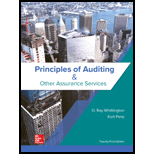
EBK PRINCIPLES OF AUDITING & OTHER ASSU
21st Edition
ISBN: 9781260299434
Author: WHITTINGTON
Publisher: YUZU
expand_more
expand_more
format_list_bulleted
Question
Chapter 14, Problem 33BOQ
To determine
Identify the appropriate answer related to the design of the audit for the accounts payable account.
Expert Solution & Answer
Want to see the full answer?
Check out a sample textbook solution
Students have asked these similar questions
Lynn Inc has provided the following data from its activity-based system
The GNR Manufacturing Co. recorded overhead costs of $21,500 at an activity level of 5,000 machine hours and $8,000 at 2,500 machine hours. The records also indicated that overhead of $10,000 was incurred at 4,200 machine hours. Using the high-low method to estimate the cost equation, determine the variable cost per machine hour.
Need help this question solution please
Chapter 14 Solutions
EBK PRINCIPLES OF AUDITING & OTHER ASSU
Ch. 14 - If a corporation overstates its earnings, are its...Ch. 14 - Prob. 2RQCh. 14 - Prob. 3RQCh. 14 - Prob. 4RQCh. 14 - Prob. 5RQCh. 14 - Prob. 6RQCh. 14 - Prob. 7RQCh. 14 - Prob. 8RQCh. 14 - List the major responsibilities of an accounts...Ch. 14 - Prob. 10RQ
Ch. 14 - Prob. 11RQCh. 14 - Prob. 12RQCh. 14 - Prob. 13RQCh. 14 - Prob. 14RQCh. 14 - Prob. 15RQCh. 14 - Prob. 16RQCh. 14 - Prob. 17RQCh. 14 - Whitehall Company records its liabilities in an...Ch. 14 - Prob. 19RQCh. 14 - Prob. 20RQCh. 14 - Prob. 21RQCh. 14 - Prob. 22RQCh. 14 - What is the purpose of the auditors review of cash...Ch. 14 - Prob. 24RQCh. 14 - Prob. 25RQCh. 14 - Prob. 26RQCh. 14 - Prob. 27QRACh. 14 - Prob. 28QRACh. 14 - Prob. 29QRACh. 14 - Prob. 30QRACh. 14 - Prob. 31QRACh. 14 - Prob. 32QRACh. 14 - Which of the following procedures is least likely...Ch. 14 - Prob. 33BOQCh. 14 - Which of the following is the best audit procedure...Ch. 14 - Prob. 33DOQCh. 14 - Prob. 33EOQCh. 14 - Prob. 33FOQCh. 14 - Prob. 33GOQCh. 14 - Prob. 33HOQCh. 14 - Ordinarily, the most significant assertion...Ch. 14 - Prob. 33JOQCh. 14 - Prob. 33KOQCh. 14 - Prob. 33LOQCh. 14 - Prob. 34OQCh. 14 - Prob. 35OQCh. 14 - Prob. 36OQCh. 14 - Prob. 37OQCh. 14 - Prob. 38PCh. 14 - Prob. 39PCh. 14 - Prob. 40PCh. 14 - Prob. 41PCh. 14 - Prob. 42PCh. 14 - Prob. 43ITC
Knowledge Booster
Similar questions
- I am trying to find the accurate solution to this financial accounting problem with appropriate explanations.arrow_forwardAt the year end ??? No solve incorrect valuesarrow_forwardNo aiPlease don't answer i posted blurred image mistakely. please comment below i will write values. if you answer with incorrect values i will give unhelpful confirm.arrow_forward
arrow_back_ios
SEE MORE QUESTIONS
arrow_forward_ios
Recommended textbooks for you
 Auditing: A Risk Based-Approach (MindTap Course L...AccountingISBN:9781337619455Author:Karla M Johnstone, Audrey A. Gramling, Larry E. RittenbergPublisher:Cengage Learning
Auditing: A Risk Based-Approach (MindTap Course L...AccountingISBN:9781337619455Author:Karla M Johnstone, Audrey A. Gramling, Larry E. RittenbergPublisher:Cengage Learning Auditing: A Risk Based-Approach to Conducting a Q...AccountingISBN:9781305080577Author:Karla M Johnstone, Audrey A. Gramling, Larry E. RittenbergPublisher:South-Western College Pub
Auditing: A Risk Based-Approach to Conducting a Q...AccountingISBN:9781305080577Author:Karla M Johnstone, Audrey A. Gramling, Larry E. RittenbergPublisher:South-Western College Pub

Auditing: A Risk Based-Approach (MindTap Course L...
Accounting
ISBN:9781337619455
Author:Karla M Johnstone, Audrey A. Gramling, Larry E. Rittenberg
Publisher:Cengage Learning

Auditing: A Risk Based-Approach to Conducting a Q...
Accounting
ISBN:9781305080577
Author:Karla M Johnstone, Audrey A. Gramling, Larry E. Rittenberg
Publisher:South-Western College Pub